A promising, unpretentious and productive potato variety “Désiré” from Dutch breeders
Varieties and hybrids of Dutch selection are widely used throughout the world due to their striking characteristics. Desiree potatoes are no exception; they have gained enormous popularity in a short time, showing high yields and resistance to diseases. The taste of potatoes increases the prospects of the crop. It is used not only in private households, but also in large industries for the preparation of fast food products.
What kind of potato is this?
The Desiree variety is a table type with a high starch content. Widely used on farms for growing for sale. It is in high demand not only in retail trade, but is also purchased by large processing enterprises and restaurant chains.
Origin and development
The homeland of the Desire potato is Holland, the Netherlands. The originator is the breeding company HZPC HOLLAND B.V. In English, the name of the variety is translated as “desire” and, in general, is supported by its super characteristics.
When developing the variety, breeders focused on increased yield. The task was successfully completed, and after numerous tests the crop confirmed its ability to bear fruit above standard norms. This fact interested entrepreneurs, and soon the variety occupied numerous fields throughout the West.
In Russia, Desiree gained popularity in the late 90s.At the same time it was included in the state register of selection achievements.
Distinctive features, appearance
The average weight of the tubers is 80-100 g, oval in shape, smooth skin with a reddish tint, few eyes. The pulp is light yellow, even lemon-colored, and the taste is sweetish. The starch content ranges from 14-21%. The formation of starch is influenced by the growing conditions of the plant.
The use of vegetables is universal - from preparing absolutely any dish to processing in large enterprises.
Thanks to the strong peel, the safety of the fruit is kept at a high level - at least 97% of the total mass. Vegetables are subject to long-term transportation and retain their presentation.
The nutritional value of tubers is undeniable: they contain a lot of protein, carotene and mineral salts.
The photo shows Desiree potatoes.
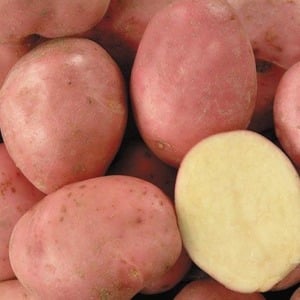
Description of the variety
The bush is medium-sized, moderate spreading, the leaves are dark green, medium-sized. The root system is well developed, the stem is powerful. When flowering, the bush produces medium-sized purple flowers collected in a compact corolla.
The plant is characterized by increased immunity to potato canker and viral diseases, as well as late blight of tubers, but is weakly resistant to late blight of leaves.
Seedlings quickly adapt to drought, but cannot tolerate sudden cold weather and excess moisture.
Average ripening time – from the moment of landing 80-90 days pass until full maturity. The seed material does not degenerate; the genetic fund is preserved for a long time.
Productivity
The characteristics of the variety should be supplemented with yield indicators. 150-390 centners of potatoes are harvested from 1 hectare. The harvest volume is affected by weather conditions, soil composition and care during the growing season.So, potatoes will not produce good fruit when planted in clay soil.
One bush produces up to 20 aligned potatoes of the same size. There are practically no small tubers of a non-marketable type.
How to Grow Desiree Potatoes
Light sandy soil with normal acidity is suitable for growing the crop. Timely application of fertilizing significantly affects the fruiting rate.
Reference. When the soil is highly acidic, sorrel, meadow grass and blueberries grow on the site. It is not recommended to plant potatoes in such soil. To reduce acidity, add dolomite flour or slaked lime to the soil.
Pre-sowing treatment
Seed material is prepared a month before planting. After long-term storage, it is carefully inspected for visible damage and healthy, light-colored specimens are selected.
The usual weight of planting tubers does not exceed 100 g. Potatoes are laid out in a bright room at a temperature of at least +16°C for germination.
Reference. Only sprouted tubers are planted. If there are no sprouts, there will be no shoots.
Planting begins as soon as the sprouts reach 2-2.5 cm. Immediately before sowing, the tubers are treated with a growth stimulant, for example, the drug “Kornevin”. The product will protect potatoes from diseases and speed up germination.
Dates, scheme and rules of planting
Planting begins at soil temperature +10°C and air temperature +17...+19°C. Typically, this temperature regime is established in late April - early May.
The soil is prepared in the fall: it is dug up with the addition of humus and wood ash, thereby increasing its fertility. In the spring, two weeks before sowing, they dig again.
Reference. When digging the soil, most pests living in the soil and fungal spores are destroyed.
Planting pattern: 30-35 cm – distance between seedlings, at least 75 cm – row spacing. The depth of the holes is 8-10 cm. A little humus is placed at the bottom of each hole, the seed material is laid out with the sprouts facing up and sprinkled with wood ash.
Further care
Caring for the crop is simple and comes down to standard procedures. This is another reason why farmers prefer to grow Desiree potatoes on an industrial scale. It takes little time and effort, but the result exceeds expectations.
Watering
The variety does not need frequent watering. It is not afraid of drought, but does not tolerate high humidity. Water abundantly only on sultry and hot days - moisture is necessary for the full formation of tubers.
Reference. The best type of irrigation is drip irrigation. Water goes directly to the root system without increasing the humidity level in the beds.
Loosening is important to improve breathability. Oxygen is necessary for plant life.
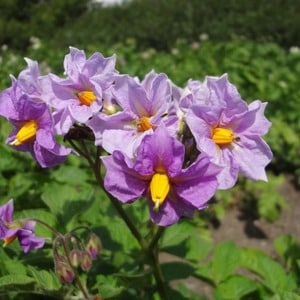
As the weeds grow, weeding is carried out. Weeds are a serious threat to the health of seedlings. Numerous pests and fungal spores multiply in the grass, which subsequently spread to potatoes and other crops.
After weeding, the beds are mulched with peat, dry sawdust or straw. Mulching saves plantings from ground pests and prevents the growth of weeds.
Hilling is carried out twice per season. The soil from the rows is raked onto the plants with a hoe. The procedure protects the tubers not only from sunlight, but also from the penetration of dangerous pests such as wireworms.
Feeding
As mentioned earlier, fertilizing significantly affects fruiting, increasing the quantitative indicator. Fertilizing the soil begins during digging, in autumn and spring. Humus and ash are added to the soil, increasing its nutritional value.
After planting potatoes, after two weeks, the seedlings are fed with nitrogenous substances to increase green mass.
The second fertilizing is applied at the time of flowering. Fertilize with organic matter - bird droppings in a ratio of 1:10.
Important! If diluted insufficiently, a strong concentration of organic compounds will cause root burns.
1-2 weeks before the start of fruiting, potatoes are fed with a complete mineral complex with the addition of potassium sulfate. Organic fertilizers are added to strongly acidic soil, since, unlike minerals, organic matter is better absorbed in an acidic environment.
Disease and pest control
To avoid late blight, plantings are sprayed with copper-containing preparations. Moreover, absolutely all plants on the site are treated. Late blight is a fungal disease, and when it affects one crop, fungal spores quickly attack other seedlings. The disease spreads quickly, destroying up to 70% of all plantings.
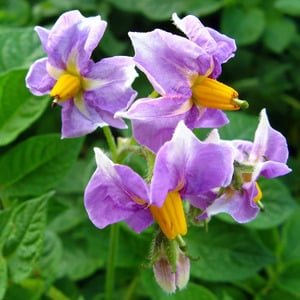 The optimal conditions for its development are high humidity combined with high temperature. This is why it is important to control the moisture level in the beds. Moderate watering, systematic loosening and fertilizing are also considered to prevent diseases and increase the immunity of seedlings.
The optimal conditions for its development are high humidity combined with high temperature. This is why it is important to control the moisture level in the beds. Moderate watering, systematic loosening and fertilizing are also considered to prevent diseases and increase the immunity of seedlings.
When affected by late blight, the diseased plants are destroyed, and the remaining plantings are treated with “Fitosporin”. This drug belongs to the contact fungicides and performs preventive and therapeutic functions.
Preparations such as Medvetox and Prestige will help protect seedlings from insect pests, in particular the mole cricket and the Colorado potato beetle. Medvetox granules are buried several centimeters into the ground, since the mole cricket lives underground and harms the root system.
The drug "Prestige" is used against the Colorado potato beetle if there is a lot of the pest in the beds. When the number is small, the insect is collected by hand, carefully inspecting the plants from all sides.
Collection, storage and use of crops
The first tubers ripen by mid-summer, but the mass harvest occurs in September. Two days before harvest, the tops are mowed. It is not advisable to leave it on the field, as pests that can harm the tubers may remain in it.
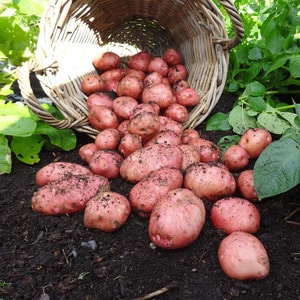 After digging the potatoes out of the ground, they are left in the sun for several hours to dry. If the sun is bright and scorching, a canopy should be provided.
After digging the potatoes out of the ground, they are left in the sun for several hours to dry. If the sun is bright and scorching, a canopy should be provided.
After drying, the potatoes are placed in wooden boxes and sent to a dry, cool room for further storage. They are also used for transportation to any distance.
Thanks to their excellent sweetish taste and non-watery structure, potatoes are used in a variety of ways in cooking: baked, boil, fried, stewed with other vegetables and meat and used as a filling for pies. The friability of vegetables allows you to get a tasty and airy puree.
In addition to home cooking, potatoes are used in mass production for the preparation of semi-finished products and chips.
Advantages and disadvantages of the variety
Desiree has the following advantages:
- ease of care;
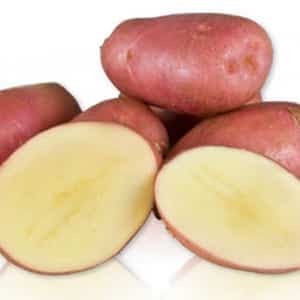
- resistance to many diseases;
- increased productivity;
- adaptation to drought;
- high taste qualities;
- excellent transportability;
- long-term storage;
- preservation of the gene pool;
- possibility of quick implementation;
- versatility in cooking.
Disadvantages include susceptibility to late blight and poor tolerance of excess moisture.
For which regions is it best suited?
The Desiree potato variety can grow throughout the Russian Federation. But potatoes delight residents of the southern regions with the richest fruiting.
Reviews
Positive feedback confirms the trustworthiness of the culture. Many gardeners prefer it, despite the variety of varieties.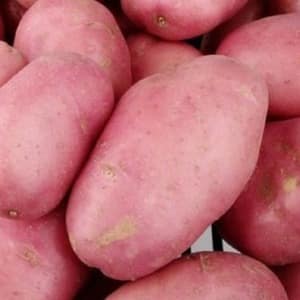
Vladimir, Moscow: “After reading about the increased yield, at first I thought that the crop belonged to the fodder crop. Having familiarized myself with the characteristics in more detail, I realized that it is a table variety. I tried it in my garden beds the same year. The harvest was good. Potatoes are high quality and tasty. I'm thinking about growing it for sale. There is good demand for these vegetables.”
Elena, Saratov region: “I like these potatoes because of their sweet, rich taste. Its friability is moderate, I cook any dishes, it is good in baking, boiling and pureeing. I also make salads in winter. With mayonnaise, potatoes are especially pleasing with their taste.”
Read also:
What are the benefits of potato juice for hair and how to use it correctly.
The Lasunok potato variety is loved by farmers for its ease of care and productivity.
Conclusion
The Desiree potato variety is characterized by increased yield, resistance to many dangerous diseases, simple agricultural technology and increased demand in markets. Potatoes are in demand in private households and in large processing enterprises.